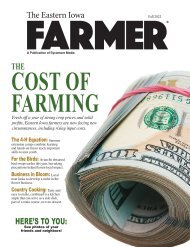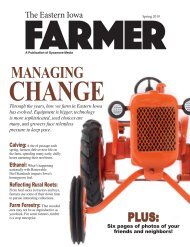You also want an ePaper? Increase the reach of your titles
YUMPU automatically turns print PDFs into web optimized ePapers that Google loves.
eastern iowa farmer photo / Lowell Carlson<br />
Corn grown on eastern <strong>Iowa</strong> farms like the Larry Johnson farm east of Maquoketa moves quickly from field to<br />
storage to market. The journey for export corn and soybeans can end thousands of miles away and across the Pacific.<br />
Once the crop disappears into an area<br />
terminal elevator’s gigantic storage<br />
facilities, that’s it for most producers.<br />
Besides, it may go into storage for<br />
months before beginning the journey.<br />
With plenty of 2015 crop still stored,<br />
that is a real possibility.<br />
Here in the upper Mississippi Valley<br />
corridor, we have the distinct advantage<br />
of water, highway and rail for crop<br />
movement.<br />
Barge transport is the lynch pin<br />
for bulk grain shipments here in the<br />
Mississippi River corridor, but the<br />
diversion to other transport, and uses,<br />
like ethanol, has changed that equation.<br />
Barge transport, hands down, is the<br />
cheapest per ton mile but is limited by<br />
weather when locks shut down from<br />
December into March. Trucks dominate<br />
for local and regional hauls, of<br />
course.<br />
Class I railroads, like Warren Buffett’s<br />
BNSF (Burlington Northern<br />
Santa Fe), Union Pacific and Canadian<br />
Pacific have invested heavily in<br />
commodity transportation facilities and<br />
focused on unit trains, a train made<br />
entirely of specific cars, destined for<br />
the same location.<br />
That development has had a dramatic<br />
and far-reaching impact. These new<br />
trains bypassed small country elevators<br />
that didn’t become high speed loadout<br />
facilities. They cut shipping on<br />
the Great Lakes and made the Pacific<br />
Northwest ports like Vancouver,<br />
Tacoma and others busy rail and ocean<br />
shipping hubs.<br />
Right now about 25 percent of all<br />
grain bound for export markets moves<br />
through terminals in the Pacific Northwest,<br />
and nearly half of all wheat<br />
exports move through Columbia River<br />
and Puget Sound grain terminals.<br />
Nearly all of the soybeans shipped out<br />
of the Northwest head to China. Yellow<br />
dent corn goes primarily to Korea,<br />
Japan, Philippines and China. Middle<br />
East markets are also served by Pacific<br />
Northwest terminals.<br />
<strong>Iowa</strong> State University ag economists<br />
say, under most circumstances, the<br />
most fuel-efficient route for shipping<br />
grain from <strong>Iowa</strong> is through West Coast<br />
ports, even though it has not been the<br />
most efficient route. That is changing.<br />
At places like Kalama, Washington,<br />
corn, soybeans and wheat from <strong>Iowa</strong><br />
and the Midwest move in volumes that<br />
stagger the imagination. The TEMCO<br />
Kalama Terminal is one of a number of<br />
facilities in the Northwest undergoing<br />
upgrade.<br />
A joint venture by Cargill and CHS,<br />
a mega farmer-owned cooperative,<br />
Kalama is state-of-the-art technology.<br />
The rail yard is capable of accommodating<br />
four shuttle trains, about 450<br />
railcars. The grain terminal can unload<br />
two shuttles simultaneously and move<br />
and discharge 120,000 bushels per<br />
hour into moored bulk carriers. Rail<br />
receiving unloading rates are 115,000<br />
bushels per hour, and it takes 8.5 hours<br />
to unload a unit train.<br />
Cargill pioneered the idea of grain<br />
unit trains back in the mid-1960s with<br />
the Illinois Central when an elevator<br />
arranged for 115 jumbo cars to<br />
haul 400,000 bushels of corn to New<br />
Orleans, 1,300 miles away. The unit<br />
train actually originated with the coal<br />
industry. In some cases, unit train rates<br />
were half the cost of single car rates.<br />
With 94 storage silos and steel bins<br />
the expanded export terminal expects<br />
to move 250 million bushels a year.<br />
During peak operations it moves up to<br />
two million bushels every 24 hours.<br />
All this with a staff of 50 people<br />
working in the rail department, storage,<br />
and loading. n<br />
— lowell carlson, eastern iowa farmer<br />
fall <strong>2016</strong> | <strong>Eastern</strong> <strong>Iowa</strong> <strong>Farmer</strong> 89

















